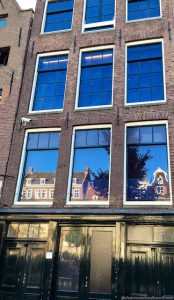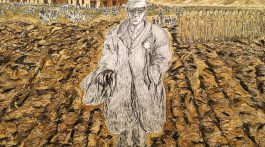Imagine living in a world shrouded in darkness, black out. Not being able to smell the fresh air or feel the sun, the rain or the wind. To always have to be quiet, “no running water, no flushing toilets, no walking around no noise whatsoever” Anne Frank, 23 August 1943
Imagine existing in a world with the constant terror of being discovered and without the everyday things we take for granted. “I long to ride a bike, dance, whistle, look at the world and know that I am free” Anne Frank, 25 December 1943
 And imagine a world which created this situation, making it necessary for people to be forced to hide and lock themselves away. And despite your degradation and fear, still being able to preserve your sanity and belief that good would triumph over evil. “I simply can’t build my hopes on a foundation of confusion, misery and death… I think… peace and tranquility will return again.”Anne Frank.
And imagine a world which created this situation, making it necessary for people to be forced to hide and lock themselves away. And despite your degradation and fear, still being able to preserve your sanity and belief that good would triumph over evil. “I simply can’t build my hopes on a foundation of confusion, misery and death… I think… peace and tranquility will return again.”Anne Frank.
Anne Frank was born in Frankfurt on 12 June 1929, she was an innocent 12 year old girl who along with her family and four others lived in such a world for over two years Their only ‘crime’ being they were Jews. Believing that all hope of escaping the Nazis had vanished, Anne’s father, secreted them away into the upper floors of an annex, concealed by a movable bookcase, in the building his companies’ occupied, opposite a canal in the middle of Amsterdam.
 They were there for just over two years, 6 July 1942 to 4 August 1944, nearly two months after but not
They were there for just over two years, 6 July 1942 to 4 August 1944, nearly two months after but not
in time for Anne. They were assisted by some of Otto’s brave employees, Victor Kugler, Miep Gies, Johannes Kleiman and Bep Voskuijl, despite the enormous risk to their own lives, they illegally smuggled in food. As the war intensified this became increasingly difficult, “as of tomorrow we won’t have a scrap of fat, butter or margarine. Lunch today consists of mashed potatoes and pickled kale. You wouldn’t believe how much kale can stink when it’s a few years old!” 14 March 1944
Listening to the BBC on their small radio, Anne and the others followed the progress of the war, clinging to the hope of an Allied Victory. It is not known known who ultimately betrayed them to the Nazis, the S.S. raided their hiding place on 4 August 1944.
They were taken to the holding camp Westerbork and on 3 September 1944 were sent to Auschwitz-Bikenau. On 1 November 1944 the family were separated forever when the girls were sent to work at Bergen-Belsen. Only Otto, survived. He returned to Amsterdam on 3 June1945 knowing his wife was lost but hoping his 2 girls had endured. When Otto was reunited with Miep Gies she gave him all that was left of his daughters, the diary and letters written by Anne. ‘I’ll make my voice heard I’ll go out in the world and work for mankind’ Anne Frank, 11 April 1944
 When Otto read his daughter’s words he was captivated and despite the painful memories they evoked he was amazed by her accurate, thoughtful descriptions. Otto dedicated the rest of his life to combating discrimination and prejudice and became instrumental in creating the Anne Frank Huis to preserve her story for ever. “We cannot change what happened. The only thing we can do is to learn from the past and to realize what discrimination and persecution of innocent people means. I believe that it is everyone’s responsibility to fight prejudice” Otto Frank 1970
When Otto read his daughter’s words he was captivated and despite the painful memories they evoked he was amazed by her accurate, thoughtful descriptions. Otto dedicated the rest of his life to combating discrimination and prejudice and became instrumental in creating the Anne Frank Huis to preserve her story for ever. “We cannot change what happened. The only thing we can do is to learn from the past and to realize what discrimination and persecution of innocent people means. I believe that it is everyone’s responsibility to fight prejudice” Otto Frank 1970
On 25 June 1947 Anne’s diary was published for the first time, it was printed in Dutch in the Netherlands. It has become one of the most widely read books in the world, realising Anne’s dreams of being a writer and making a difference “I want to be useful or bring enjoyment to all people, even those I’ve never met. I want to go on living even after my death!”
You can learn more about Anne Frank’s incredible story here
To visit the Anne Huis, book your tickets in advance. ALL visits before 3.30pm require a pre booked online ticket. After 3.30pm you take your chances in the long lines, pre-booking advised!





No Comment